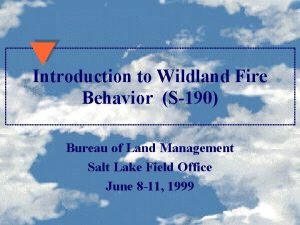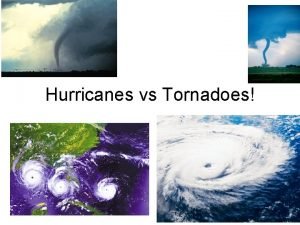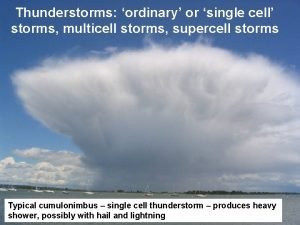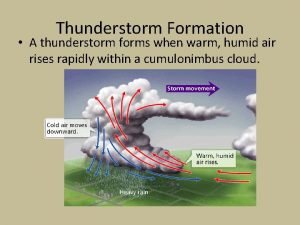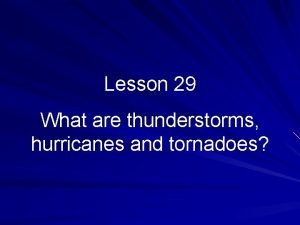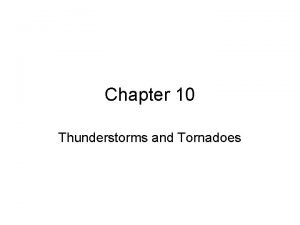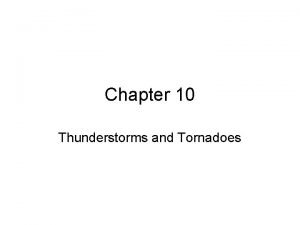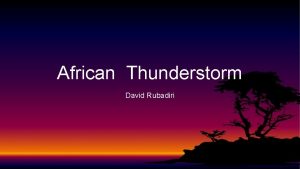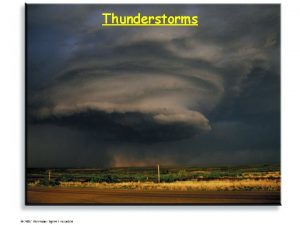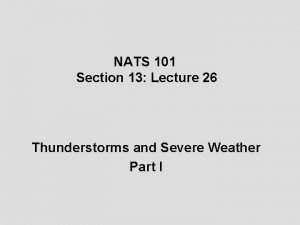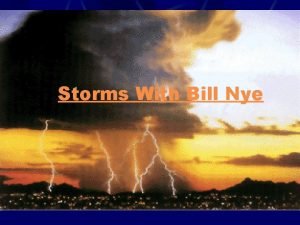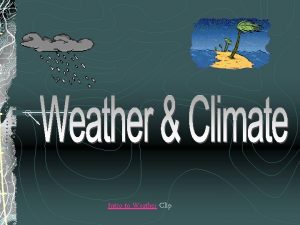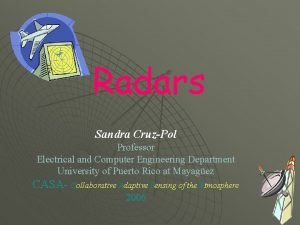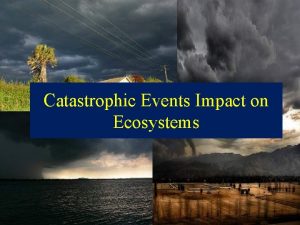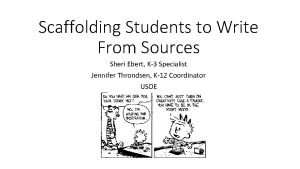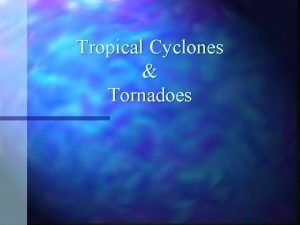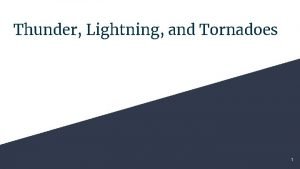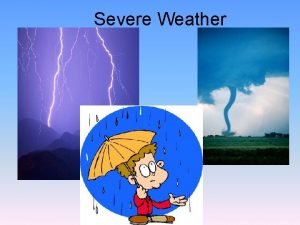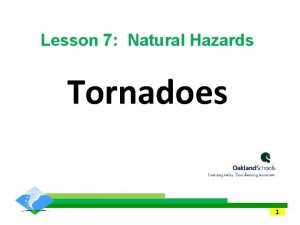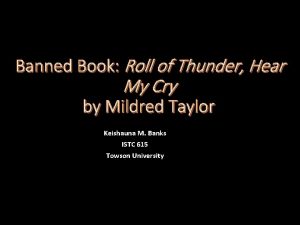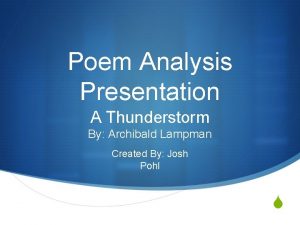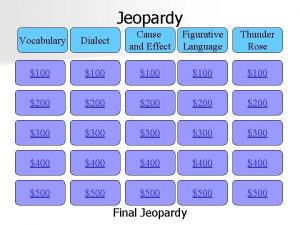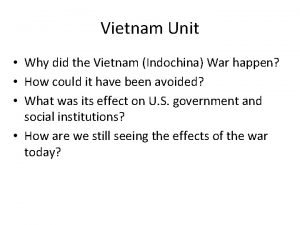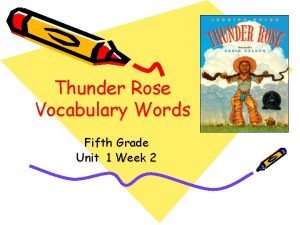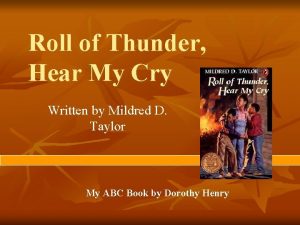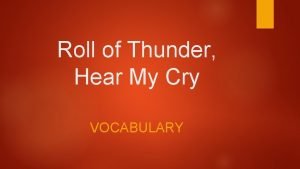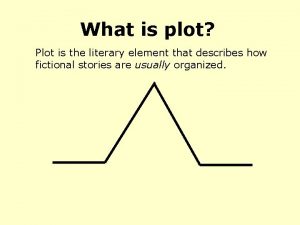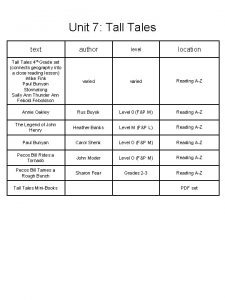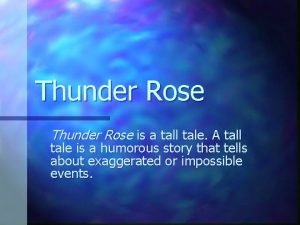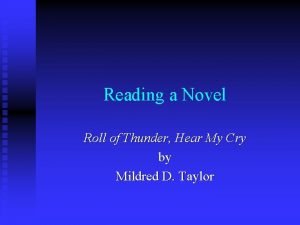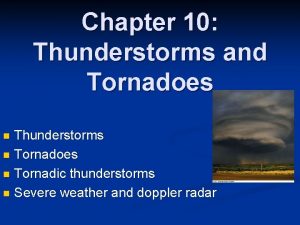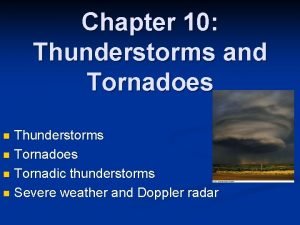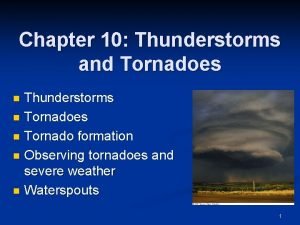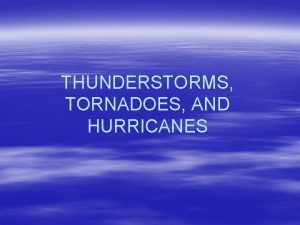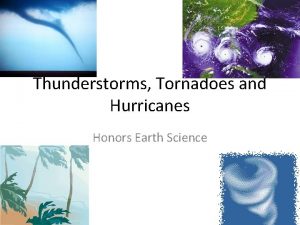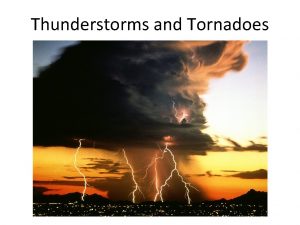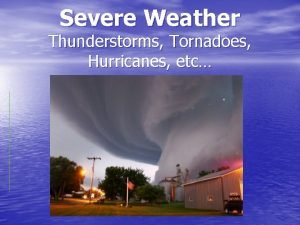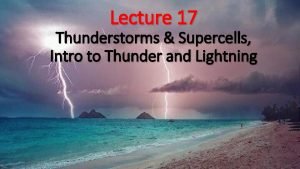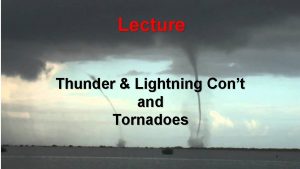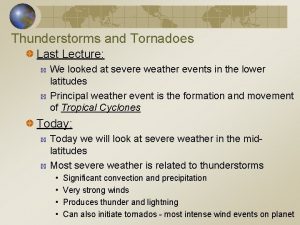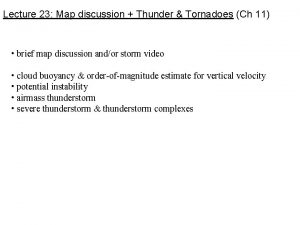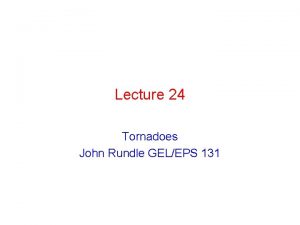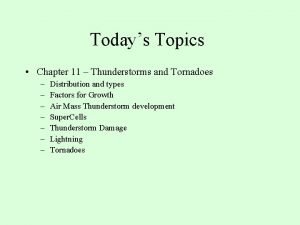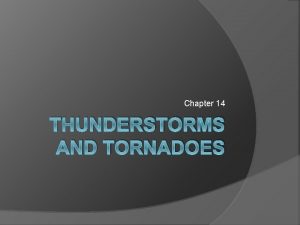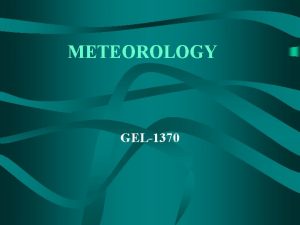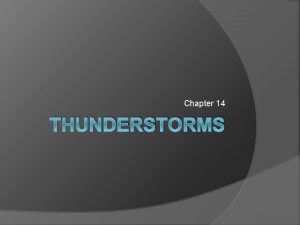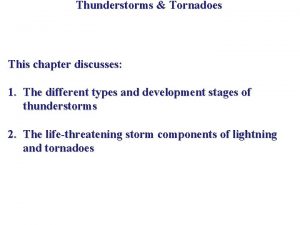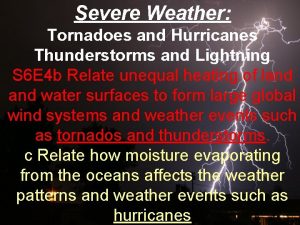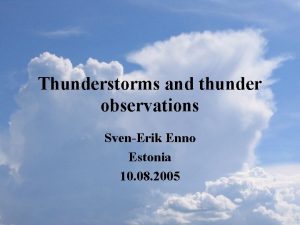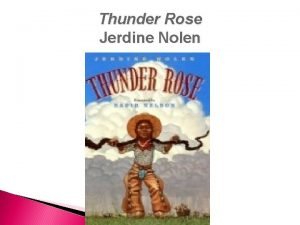Lecture 19 Chapter 11 Thunderstorms and Tornadoes Thunder

























































- Slides: 57

Lecture 19 Chapter 11 Thunderstorms and Tornadoes

Thunder Storms • Cluster of clouds producing heavy rain, lightning, thunder, hail or tornados • enormous energy • Moist air, strong convection • Vary in length, precipitation and windiness

Thunderstorm Requirements • Warm moist air • Lifting – mountains or frontal cyclones • Thunderstorms often follow midlatitude storm tracks

Satellite View

Satellite View II

Growth and Development • Affected by – – Unstable atmosphere Environmental Temperature Humidity Wind speed and direction (surface to tropopause) – Vertical Wind Shear – adds spin – Nocturnal Jet – moisture and energy – Capping inversion – the lid on a boiling pot

Lifting Index • A measure of convective potential – Compares Tparcel to Tenvironment – When Tp >Te, convection is possible • Te-Tp – -3 to -6 marginal instability – -6 to -9 moderate instability – < -9 very unstable air

Types of Thunderstorms • Composed of cells – Ordinary- short lived and small – Super- large, last for hours • Single Cell • Multi Cell – Squall line – Mesoscale convective complex

Ordinary Single Cell • Short-lived, last for ~1 hour, localized • Stages – Cumulus – Mature – Dissapating


Cumulus stage • Moist surface air rises and cools at dry adiabatic lapse rate until Lifting Condensation Level (LCL) is reached • Entrainment from dry environmental air – Evaporation of droplets, helps cool air – Variability in droplet size – If cloud is higher than freezing point ->mixed phase and precipitation can form

Mature Stage • Precipitation begins to fall • Lightning, hail and rain maximized • Updrafts strongly organized • Falling precipitation occurs when air is unsaturated, promotes downdrafts of cool dense air

Dissipating stage • Updraft Collapses • Downdraft dominates, creates drag, snuffs updraft • Moisture source lost, convection slows • Dry environmental air entrains • Cloud dissipates

Ordinary Single Cell

Multi Cell Systems • Number of seperate individual cells at differing stages • Last several hours • 2 basic types – Squall line – Mesoscale convective complex (MCC)

Note how the downdrafts assist the updrafts –provide lifting

Shelf cloud above gust front

Squall line • Line of storms often following or ahead of a front • Boundaries of unstable air • 6 to 12 hours long • Long (span several states) • Wind shear separates updraft, downdraft • Shelf cloud above gust front

Conditions for Squall line • Divergence aloft • Most low level inflow • Squall lines often appear ahead of cold fronts in plains and midwest

Squall Line

Squall line

Mesoscale Convective Complex • Complex arrangement of individual storms • 100 K Km 2 (Iowa) • High pressure in upper levels • Do not require high wind shear • Long lived – Mature in late afternoon – Die in early morning (dawn)

MMC requirements • Low level moisture source • Low level jet that rises over downdrafts • Jet weakens at sunrise, MMC breaks up • Important source of water for US Great Plains

Super Cell • Rotating Single Cell system • Development depends on instability and wind shear (low level southerly, upper level westerly) • Updrafts and downdrafts are separate • Produces dangerous weather – Rain, hail, lightning, Tornadoes

Super Cell Structure

Structure of Supercell • Updraft goes in at rain free base, moves ahead and downwind • Anvil and overshooting tops indicate strong updrafts • Upper level winds help maintain movement • Downdraft in precipitation core

Auntie Em, it’s a twister

Tornadoes • Rapidly Rotating columns of high wind around a low beneath a thunderstorm • Visible Funnel due to condensation, dust and debris in rapidly rising air • Funnel cloud is not a tornado until it touches ground

Funnel Cloud

Tornado

Just the facts • ~1. 6 km wide • Short lived <30 minutes • Hard to understand due to violent nature • Related to rotating super cell thunderstorms • Movement with storm track, NE in US

Rotation • Begins in interplay between updrafts and downdrafts • Air spins around horizontal axis near front • Meso cyclone (5 to 20 km wide) • Updrafts lift column and 2 columns form – Vertical axis – Left and Right movers – Vertical stretching increases spin

Spinning air lifted

Not a nice day for fishing

A twister is born • Cloud under spinning updraft lowers in a rotating cloud wall – Small compared to meso cyclone • Funnel Cloud – Water vapor makes circulation visible – Touchdown - start of tornado

Touchdown!! Extra point is no good!

Life Cycle • Organizing • Mature • Shrinking • Rope

Tornado Winds • 300 mph (480 km/hr) • Force of wind proportional to v 2 • 4 times more powerful than category 5 Hurricane • Ted Fujita – 1970 – Category F 1 to F 5 – 1% category 4, 5

Source and Distribution • strongest winds in direction of background flow • Strong tornadoes show multiple vortices • Geographical distribution – Possible in any state – Areas of instability, wind shear, frontal movement

Tornado Alley

Tornado Season • Follows Jet stream (source of wind shear) – Minnesota- June – Mississippi- Spring and Fall • Could happen day or night • Attraction to trailer parks?

Severe Weather • Lightning • Hail • Floods • Severe winds

Lightning • Electrical discharge • Rising and sinking air motions • 85 deaths, 300 injured per year • 1 in 600, 000 • Can travel – Cloud to cloud – Cloud to ground – Inside individual clouds

Charge Separation • Charges distributed throughout cloud – Ice particle- graupel collisions – When T<-15 o. C • Graupel-negative • Ice Crystals-positive – Updrafts move and separate charges • Ice up • Graupel down – Cloud induces surface charge

Ground Charge • • Attraction to cloud High pointy metal structures Large charge separation Air acts to insulate, allows potential buildup • 3000 volts/ft • 9000 volts/m

Lightning Formation • Large charge buildup and separation • Pilot leader • Stepped leaders- branches act as conductive channels • Spark when channel is completed to ground • Electrons flow in series of flashes

Lightning Stroke

Flash Floods • Input of water faster than removal, absorption or storage • Local • High volume • Short duration • Breaking dam

Controls • • • Rainfall intensity Topography Soil conditions Ground cover Steep terrain funnels flow Extremes in soil moisture

Kodak moment

Water Spouts

Hail • Lumps of layered ice • Formed through accretion, require super cooled drops • Strong tilted updrafts • Vertical Cycling • Hail embryos ~1 mm • Hail shaft

Hail

Wear a helmet

Is this guy for real?

Bombs away

Blasted Hail!
 Compare and contrast tornadoes and hurricanes
Compare and contrast tornadoes and hurricanes Contrast signal words
Contrast signal words Three visual indicators of lightning and thunderstorms
Three visual indicators of lightning and thunderstorms 01:640:244 lecture notes - lecture 15: plat, idah, farad
01:640:244 lecture notes - lecture 15: plat, idah, farad Hurricanes and tornadoes similarities
Hurricanes and tornadoes similarities Multicell thunderstorm
Multicell thunderstorm Thunderstorms form when warm, humid air rises in a
Thunderstorms form when warm, humid air rises in a What clouds have the greatest turbulence
What clouds have the greatest turbulence What are thunderstorms
What are thunderstorms Cumulus stage of a thunderstorm
Cumulus stage of a thunderstorm Tornado
Tornado Thunderstorm poem summary
Thunderstorm poem summary Thunderstorms
Thunderstorms Downdraft
Downdraft Bill nye storms
Bill nye storms What causes lightning brainpop
What causes lightning brainpop Tornadoes games
Tornadoes games Night of the twisters by ivy ruckman
Night of the twisters by ivy ruckman What impact does a tornado have on an ecosystem?
What impact does a tornado have on an ecosystem? How do tornadoes affect humans
How do tornadoes affect humans Tropical cyclone tornadoes
Tropical cyclone tornadoes Tornadoes
Tornadoes Tornado cupcake cake
Tornado cupcake cake Three ingredients for a thunderstorm
Three ingredients for a thunderstorm Effects of tornadoes
Effects of tornadoes Summary of chapter 4 roll of thunder hear my cry
Summary of chapter 4 roll of thunder hear my cry Disney conglomerate
Disney conglomerate Theme in sound of thunder
Theme in sound of thunder Thunder bay humane society
Thunder bay humane society This supernatural soliciting cannot be ill
This supernatural soliciting cannot be ill Roll of thunder hear my cry n word
Roll of thunder hear my cry n word Thunderstorm poems
Thunderstorm poems Ntranslate
Ntranslate What causes thunder and lightning
What causes thunder and lightning Management fifteenth edition
Management fifteenth edition Human resources management chapter 1
Human resources management chapter 1 Human resource management lecture chapter 1
Human resource management lecture chapter 1 Thunder bay humane society
Thunder bay humane society What causes warm air to rise brainpop
What causes warm air to rise brainpop Napalm vietnam war
Napalm vietnam war Timmins to thunder bay
Timmins to thunder bay A thick black sticky substance made from tar or turpentine
A thick black sticky substance made from tar or turpentine Operation rolling thunder cold war
Operation rolling thunder cold war A comparison using “like” or “as”
A comparison using “like” or “as” Roll of thunder hear my cry pictures
Roll of thunder hear my cry pictures Roll of thunder vocabulary
Roll of thunder vocabulary Rolling thunder kick
Rolling thunder kick Operation rolling thunder cold war
Operation rolling thunder cold war Roar figurative language
Roar figurative language The eerie silence was shattered by her scream.
The eerie silence was shattered by her scream. Eckels sound of thunder
Eckels sound of thunder Plot diagram for a sound of thunder
Plot diagram for a sound of thunder Stormalong an american tall tale answers
Stormalong an american tall tale answers Whats a tall tale
Whats a tall tale What is this?
What is this? Shmoop roll of thunder hear my cry
Shmoop roll of thunder hear my cry Roll of thunder hear my cry characters pictures
Roll of thunder hear my cry characters pictures Aesir
Aesir


